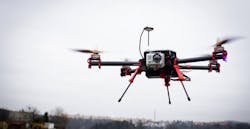When Luke Hansen, of White Castle Roofing, in Omaha, Neb., saw his first drone demonstration on YouTube, he immediately recognized the potential in unmanned aircraft systems (UAS) for his family’s roofing business. So early in 2014, Hansen began pricing drones. He found drones for $10,000 and $20,000, which was more than he wanted to spend. Then his brother sent him a link for a drone in the $1,000 range. “We had to learn how to fly it,” he recalls.
The learning curve was short but steep. Hansen crashed one drone into a tree. But he soon mastered the use of robotic aircraft. For White Castle Roofing, which does both residential and large commercial jobs, drones are an estimating dream come true (see the company video). “When someone calls us for an estimate on a 60-foot church steeple, I could get a crane over there for a close look,” Hansen says. Instead, the drone provides high-quality video and stills, at far less expense. Using its drone, White Castle Roofing was able to generate the information needed to create an estimate for re-shingling an 11-unit apartment complex of four-story buildings in about 15 minutes. Without it, Hansen says, it would have taken a company estimator “six hours of climbing onto roofs, walking the roofs, and counting shingles.”
The Advantages
White Castle Roofing is one of a handful of home improvement companies—mostly roofers—that were early adopters of drone technology. Another is Allied Remodeling of Central Md. A little more than a year ago, the Towson, Md.-headquartered company bought six drones for about $7,000. The plan was to use drone technology to eliminate the difficult, dangerous, and time-consuming task of inspecting a roof by having to actually walk it. Allied Remodeling president Dean D’Eugenio figured that between the lower workers’ comp costs and the savings involved in taking the company’s ladder trucks off the road, he could reduce expenses by $70,000 to $80,000 a year. The quality of the video and still photography is such that an Allied Remodeling drone could quickly photograph the roof and provide all the information necessary for a proposal. “Its insane,” D’Eugenio says. “If you push a pin into the roof, I can find it and show it to you in high definition.” He recalls that after a story about the company’s use of drones appeared in the Baltimore Business Journal a year ago, his phone was ringing off the hook—not with calls from homeowners, but from members of the media. “Every reporter in Baltimore wanted an interview,” he says.
Curb Your Enthusiasm
Both companies, however, have found it necessary to curb their enthusiasm—and store their drones—in the absence, up until now, of clear Federal Aviation Administration regulations on UAS use.
Drones are a relatively recent adaptation of military technology to civilian uses. The agency classifies drone use as hobby (model planes), recreational, or commercial. Commercial uses for drones vary, but are, to some, seemingly limitless, and range from inspecting crops to estimating roofs to, potentially, delivering packages. The earliest commercial users so far have included home inspectors, real estate agents, and insurance companies seeking to gather roof condition data.
But the sudden explosion of interest in drones—a September 2015 story in Fortune predicted sales of 1 million units over the recent holidays—has had the FAA scrambling to set rules for both recreational and commercial uses.
Drones can be dangerous. In the hands of inexperienced operators, they often crash, and there have been several near misses involving drones and passenger planes.
There’s also the issue of privacy. Robotic aircraft can film, photograph, or spy on anyone, anywhere.
In December, the FAA announced it would begin online registration of drones already in use. The new rules require that registrants are 13 years of age or older, are U.S. citizens or legal permanent residents, and that drone owners must register if their drone weighs more than 0.55 pounds and less than 55 pounds, including payload, such as a camera. (Drones weighing more than 55 pounds must use a different registration process.) The FAA suggests altitude limits, and would limit use to daylight hours, when drones are visible to operators.
“Under this rule,” says the FAA press release, “any owner of a small UAS who has previously operated an unmanned aircraft exclusively as a model aircraft prior to December 21, 2015, must register no later than February 19, 2016.”
The agency promises online registration for commercial drone users later this spring. That seems certain, though there is no set date. “Proposed US regulation would effectively end the ban on commercial drone flights and would allow low-altitude flights of small drones within view of a ground-based pilot,” notes the website Business Insider. The site expects sales of commercial/civilian drones to go up at a compounded growth rate of 19 percent between 2015 and 2020.
Drone Limbo
FAA foot-dragging and fear of an agency cease-and-desist order have left White Castle Roofing and Allied Remodeling somewhat in limbo regarding whether they can operate their drone units without violating some drone-related rule. Meanwhile, the agency has given large insurance companies, such as State Farm and Allstate, permission to use drones for commercial purposes, specifically for roof inspections.
Some have questioned the FAA’s legal standing when it comes to setting or enforcing drone-related rules. The FAA “can’t make laws,” says ProVideo Coalition’s Jeff Foster, and therefore has “no authority whatsoever to regulate the operation of remote-controlled model aircraft.”
Construction attorney Patrick Barthet, of The Barthet Firm, in Florida, tells Professional Remodeler that the issue, at this point, is not so much about how and when firm and final rules on commercial use will be in place, but about the unanticipated costs that may be associated with drone use in construction. “Drone use was bound to be regulated, and frankly, the FAA rules aren’t as harsh as we would have expected,” Barthet says. “As we see it, the larger issue for construction companies using drones is the availability of insurance coverage under their existing CGL [commercial general liability] policies. In many instances, contractors are finding it’s cheaper and simpler to engage an independent drone company to accomplish the needed tasks.”
Marketing Perks
For some home improvement companies, though, including Allied Remodeling, mentioned earlier, and Tulsa Renew, in Oklahoma, the aura of tech expertise that drone use confers—from a marketing standpoint—is as valuable as is its data-gathering function.
In September, for instance, Tulsa Renew put a page up on its website touting the company’s new drone, mentioning that one of the drone’s benefits is its ability to keep homeowners informed of job progress as a typical 10-day fiber-cement siding job takes place.
For a year, Storm Group Roofing, in Minneapolis, has used its drone to generate data for creating estimates, as well as before and after photos of roof projects. “We’ve received a number of testimonials stating our brand new roofs were the key to sell properties for [the] asking price,” the company states on its website. “And the best part: our drone photos are 100 percent free. We have never charged for this service and love providing our valued customers with this added perk!”
About the Author

Jim Cory
Philadelphia-based writer Jim Cory is a senior contributing editor to Professional Remodeler who specializes in covering the remodeling and home improvement industry. Reach him at [email protected].
